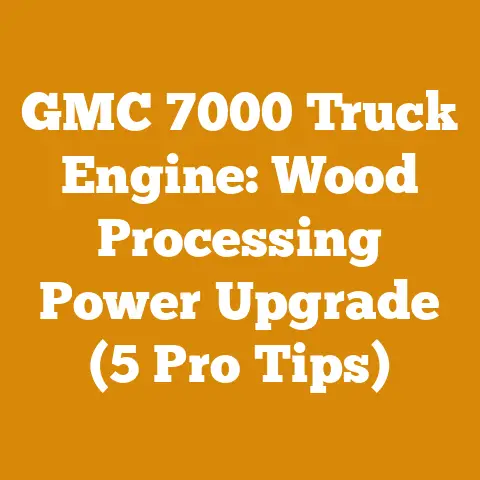Stihl Chainsaw 029 Specifications as First Saw (Pro Arborist Insights)
I’ve been there, staring at a mountain of wood, a newly acquired Stihl chainsaw, and a gnawing feeling: “Am I biting off more than I can chew?” Getting into wood processing, whether for firewood to heat your home or taking on a small logging project, can feel incredibly daunting, especially when you’re just starting out. It’s not just about the satisfying roar of the chainsaw; it’s about understanding the real costs involved, from the saw itself to the sweat equity you’re putting in. This article is about unraveling those costs, using the Stihl 029 as a potential entry point for aspiring wood pros and hobbyists, and sharing insights I’ve gained from years of working with wood.
Stihl Chainsaw 029 Specifications as First Saw (Pro Arborist Insights)
The Stihl 029, while a bit of an older model now, holds a special place for many as a robust and reliable workhorse. Its simplicity and availability on the used market make it an attractive option for someone looking for their first professional-grade chainsaw. But is it really the right choice? Let’s dig into the specifications and consider the implications for a budding arborist or firewood enthusiast.
Understanding the Stihl 029’s Core Specs
The Stihl 029, also known as the Farm Boss in some markets, typically boasts the following specifications:
- Engine Displacement: Around 56.5 cc (cubic centimeters)
- Power Output: Roughly 3.8 bhp (brake horsepower)
- Weight (Powerhead Only): Approximately 13.2 lbs (6 kg)
- Bar Length: Commonly available with 16″, 18″, or 20″ bars
- Fuel Tank Capacity: Around 18.6 oz (0.55 liters)
- Oil Tank Capacity: Around 8.5 oz (0.25 liters)
These numbers might seem abstract, but they directly impact the saw’s performance and suitability for different tasks. The engine displacement and power output dictate how easily the saw can cut through various types of wood. The weight affects fatigue, especially during prolonged use. The bar length determines the maximum diameter of wood you can safely cut.
Why the Stihl 029 Might Be a Good First Saw
- Affordability: Used Stihl 029s are often available at significantly lower prices than newer models. This can be a major advantage when starting out, allowing you to invest in other essential equipment like safety gear. I remember finding a used 029 for a steal at a local pawn shop, which allowed me to get started without breaking the bank.
- Simplicity: The 029 is a relatively simple machine compared to modern, electronically controlled chainsaws. This makes it easier to maintain and repair, which is crucial for a beginner. I’ve learned a lot about chainsaw mechanics simply by tinkering with my old 029.
- Durability: These saws are known for their robust construction and ability to withstand heavy use. While a used saw may have some wear and tear, a well-maintained 029 can still provide many years of reliable service.
- Power for Many Tasks: With around 3.8 bhp, the 029 has enough power for felling small to medium-sized trees, bucking firewood, and general property maintenance.
Potential Drawbacks to Consider
- Weight: At around 13.2 lbs (powerhead only), the 029 can be tiring to use for extended periods, especially for beginners. Lighter, more modern saws are available, but they often come at a higher price.
- Age: Being an older model, finding replacement parts can sometimes be a challenge. While many parts are still available, it’s something to keep in mind.
- Emissions: The 029 is not as fuel-efficient or environmentally friendly as newer saws that meet stricter emission standards.
- Vibration: Older saws often have less effective vibration dampening systems, which can lead to hand-arm vibration syndrome (HAVS) over time. Using proper technique and taking frequent breaks is essential.
Pro Arborist Insights: Is It Really a Pro Saw?
While the Stihl 029 is a capable saw, it’s important to be realistic about its limitations, especially from a professional arborist’s perspective. A seasoned pro might prefer a lighter, more powerful saw with advanced features like electronic fuel injection and improved vibration dampening. The 029 is more of a “prosumer” saw, bridging the gap between homeowner and professional models.
Here’s my take: For a beginner who’s serious about learning the trade, the 029 can be a great starting point. It allows you to develop your skills and gain experience without a huge initial investment. As you progress and your needs evolve, you can always upgrade to a more specialized saw.
Chainsaw Costs: A Deep Dive
Okay, you’re considering a Stihl 029 (or any chainsaw, really). Let’s talk about the nitty-gritty: the actual costs involved. This isn’t just the price tag on the saw; it’s a whole ecosystem of expenses that can quickly add up.
Initial Purchase Price: New vs. Used
This is the most obvious cost. New chainsaws, even entry-level models, can range from \$200 to \$500 or more. A used Stihl 029, depending on its condition, could be found for anywhere from \$100 to \$300.
My advice: Don’t be afraid to consider a used saw, especially if you’re on a tight budget. However, thoroughly inspect it before you buy. Check the engine compression, look for signs of damage or excessive wear, and ask about its maintenance history. If possible, have a knowledgeable friend or mechanic take a look. I’ve seen too many people get burned by buying a “bargain” chainsaw that turned out to be a money pit.
Essential Safety Gear: Non-Negotiable
Safety is paramount when operating a chainsaw. Don’t even think about firing up that saw without the proper gear. This is where I never skimp.
- Chainsaw Chaps: These protective leg coverings are designed to stop the chain in case of accidental contact. Expect to pay \$75 to \$150 for a good pair.
- Helmet with Face Shield and Ear Protection: Protect your head, eyes, and ears. A quality helmet combo will cost you \$50 to \$100.
- Gloves: Chainsaw-specific gloves provide a good grip and some level of protection. Budget around \$20 to \$40.
- Steel-Toed Boots: Protect your feet from dropped logs and potential chainsaw mishaps. Invest in a durable pair for \$100 to \$200.
Total estimated cost for safety gear: \$245 to \$490
Remember: This is an investment in your safety. Skimping here is simply not worth the risk.
Ongoing Maintenance Costs: Keeping Your Saw Running Smoothly
A chainsaw is a machine, and like any machine, it requires regular maintenance to keep it running efficiently and safely.
- Chain Sharpening: A dull chain is not only less efficient but also more dangerous. You can sharpen the chain yourself with a file and sharpening kit (around \$20 to \$50), or you can take it to a professional (typically \$10 to \$20 per sharpening). I learned to sharpen my own chains years ago, and it’s a skill that has saved me a lot of time and money.
- Bar Oil: Chainsaw bar oil lubricates the chain and bar, reducing friction and preventing wear. A gallon of bar oil typically costs \$10 to \$20.
- Fuel: Chainsaws typically run on a mixture of gasoline and two-stroke oil. The cost of fuel will depend on local gas prices and the type of oil you use. Expect to pay around \$5 to \$10 per gallon of mixed fuel.
- Air Filter: The air filter prevents dirt and debris from entering the engine. Clean the air filter regularly and replace it when necessary (around \$5 to \$10).
- Spark Plug: The spark plug ignites the fuel mixture in the engine. Replace the spark plug annually or as needed (around \$5 to \$10).
- Chain Replacement: Chains wear out over time and need to be replaced. A new chain for a Stihl 029 typically costs \$20 to \$40.
- Bar Replacement: The bar can also wear out or become damaged. A new bar for a Stihl 029 typically costs \$30 to \$60.
- Repairs: Even with regular maintenance, chainsaws can sometimes break down. The cost of repairs will depend on the nature of the problem and the cost of labor.
Estimating Annual Maintenance Costs:
This is where things get tricky, as maintenance costs will vary depending on how often you use your saw and the conditions in which you use it. However, let’s make some educated guesses:
- Occasional Use (Firewood for personal use): \$50 to \$100 per year
- Frequent Use (Small logging projects, regular property maintenance): \$100 to \$200 per year
- Heavy Use (Professional arborist, commercial firewood production): \$200+ per year
Pro Tip: Keep a detailed log of your maintenance expenses. This will help you track your costs and identify potential problems early on.
Fuel Consumption: A Hidden Expense
Chainsaws are not known for their fuel efficiency. The Stihl 029, with its 56.5 cc engine, will consume a significant amount of fuel, especially during heavy use.
Estimating Fuel Costs:
Let’s assume you’re paying \$3.50 per gallon for gasoline and \$20 per gallon for two-stroke oil. A typical fuel mixture ratio is 50:1 (50 parts gasoline to 1 part oil).
- Cost per gallon of mixed fuel: Approximately \$3.83
Now, let’s estimate fuel consumption:
- Stihl 029 fuel consumption: Roughly 0.2 to 0.4 gallons per hour, depending on the load.
Therefore, your fuel cost could range from \$0.77 to \$1.53 per hour of chainsaw use. This might not seem like much, but it can add up quickly if you’re using your saw frequently.
Fuel Cost Example:
Let’s say you’re cutting firewood for 20 hours per year. Your fuel cost could range from \$15.40 to \$30.60.
Depreciation: The Silent Killer
Depreciation is the decrease in value of your chainsaw over time. While it’s not an out-of-pocket expense, it’s an important factor to consider when assessing the overall cost of ownership. Chainsaws depreciate due to wear and tear, obsolescence, and the introduction of newer models.
Estimating Depreciation:
The rate of depreciation will depend on how well you maintain your saw and how often you use it. A well-maintained chainsaw that is used infrequently will depreciate more slowly than a heavily used saw that is neglected.
As a rough estimate, you can expect a chainsaw to depreciate by 10% to 20% per year.
Depreciation Example:
Let’s say you purchased a used Stihl 029 for \$200. After one year, it might be worth \$160 to \$180.
The Total Cost of Ownership: A Realistic Assessment
Now, let’s put it all together and estimate the total cost of ownership for a Stihl 029 over a five-year period. We’ll assume you purchased a used saw for \$200 and use it for firewood cutting (occasional use).
- Initial Purchase Price: \$200
- Safety Gear: \$300 (average)
- Annual Maintenance: \$75 (average) x 5 years = \$375
- Fuel Costs: \$20 (average) x 5 years = \$100
- Depreciation: Approximately \$100 (over 5 years)
Total Estimated Cost of Ownership (5 years): \$1075
Annual Cost of Ownership: \$215
This is a rough estimate, but it gives you a sense of the true cost of owning a chainsaw. It’s important to remember that these figures can vary significantly depending on your individual circumstances.
Beyond the Chainsaw: The Ecosystem of Wood Processing Costs
The chainsaw is just one piece of the puzzle. When you’re processing wood, whether for firewood, lumber, or other purposes, there’s a whole ecosystem of costs to consider.
Timber Acquisition Costs: Where Does the Wood Come From?
If you’re not harvesting wood from your own property, you’ll need to acquire it somehow. This can involve purchasing standing timber, buying logs, or obtaining firewood permits.
- Standing Timber: The cost of standing timber varies widely depending on the species, quality, location, and market conditions. Timber prices are typically quoted per thousand board feet (MBF). According to Forest2Market, a timber market analysis firm, average pine sawtimber prices in the Southern US ranged from \$250 to \$450 per MBF in 2023. Hardwood prices can be significantly higher, especially for valuable species like oak and walnut.
- Logs: Buying logs is often a more convenient option than harvesting standing timber. Log prices also vary depending on the species, quality, and size of the logs. Expect to pay \$50 to \$150 per ton for pulpwood logs and \$150 to \$400 per ton for sawlogs.
- Firewood Permits: Many national and state forests offer firewood permits that allow you to harvest firewood for personal use. The cost of these permits is typically quite low, often around \$20 to \$50 per cord. However, there may be restrictions on the types of trees you can harvest and the areas where you can cut.
My Experience: I’ve harvested firewood under permit in several national forests. It’s a great way to obtain wood at a low cost, but it requires a lot of hard work. Be prepared for long days of cutting, splitting, and hauling wood.
Labor Costs: Your Time is Money (or Someone Else’s)
If you’re hiring someone to help you with wood processing, labor costs can be a significant expense. Logging crews typically charge \$50 to \$100 per hour, depending on the size of the crew and the complexity of the job. Firewood handlers may charge \$15 to \$30 per hour.
The DIY Approach: If you’re doing the work yourself, it’s easy to overlook the value of your own time. However, it’s important to factor in your labor costs when assessing the overall cost of a project.
Estimating Your Labor Value:
Think about what you could be earning if you were working at your regular job instead of processing wood. This is your opportunity cost.
Example:
If you earn \$25 per hour at your regular job, you should assign a similar value to your time when processing wood.
Equipment Rental Costs: When Buying Isn’t the Best Option
For some tasks, it may be more cost-effective to rent equipment rather than buy it. This is especially true for expensive equipment that you only need to use occasionally.
- Log Splitters: Renting a log splitter can save you a lot of time and effort, especially if you’re splitting large quantities of wood. Rental rates typically range from \$50 to \$100 per day.
- Skid Steers: Skid steers are versatile machines that can be used for a variety of tasks, including hauling logs and moving firewood. Rental rates typically range from \$200 to \$400 per day.
- Chippers: Chippers can be used to turn brush and small trees into mulch. Rental rates typically range from \$150 to \$300 per day.
When to Rent vs. Buy:
Consider the following factors when deciding whether to rent or buy equipment:
- Frequency of Use: If you’ll be using the equipment frequently, buying may be the more cost-effective option.
- Storage Space: Do you have enough space to store the equipment when you’re not using it?
- Maintenance Costs: Equipment requires regular maintenance. Can you handle the maintenance yourself, or will you need to hire someone?
- Budget: Can you afford to purchase the equipment outright?
Transportation Costs: Getting the Wood Where It Needs to Go
Transportation costs can be a significant expense, especially if you’re hauling wood over long distances.
- Fuel Costs: The cost of fuel will depend on the distance you’re hauling the wood, the type of vehicle you’re using, and local gas prices.
- Vehicle Maintenance: Hauling heavy loads can put a strain on your vehicle, leading to increased maintenance costs.
- Truck Rental: If you don’t have a truck, you may need to rent one. Rental rates typically range from \$50 to \$100 per day.
Minimizing Transportation Costs:
- Source Wood Locally: Try to find wood sources that are close to your property.
- Optimize Loads: Maximize the amount of wood you haul per trip.
- Maintain Your Vehicle: Keep your vehicle in good condition to prevent breakdowns.
Permits and Regulations: Don’t Get Caught Off Guard
Depending on your location and the type of wood processing you’re doing, you may need to obtain permits or comply with certain regulations.
- Logging Permits: Logging permits are typically required for commercial logging operations. The requirements vary depending on the state and local regulations.
- Burning Permits: Burning permits may be required for open burning of brush and debris.
- Environmental Regulations: Be aware of environmental regulations related to water quality, erosion control, and wildlife protection.
Researching Permits and Regulations:
Contact your local forestry agency or environmental protection agency to learn about the permits and regulations that apply to your wood processing activities.
Drying Costs: Patience is a Virtue (and Saves Money)
If you’re processing wood for firewood, you’ll need to dry it before you can burn it. Seasoning firewood reduces its moisture content, making it easier to ignite and burn more efficiently.
- Time: The most significant cost of drying firewood is time. It typically takes six months to a year for firewood to season properly.
- Storage Space: You’ll need a place to store the firewood while it’s drying. This could be a wood shed, a tarp-covered pile, or a designated area in your yard.
- Labor: You’ll need to stack the firewood in a way that allows for good air circulation.
Estimating Drying Time:
The drying time for firewood will depend on the species of wood, the size of the pieces, and the climate. Hardwoods typically take longer to dry than softwoods. Smaller pieces dry faster than larger pieces. Hot, dry climates are ideal for drying firewood.
Rule of Thumb:
As a general rule, you can expect firewood to dry at a rate of about 1 inch per month. Therefore, a 6-inch diameter piece of firewood will take about six months to dry.
Insurance: Protecting Your Investment (and Yourself)
If you’re operating a wood processing business, you’ll need to carry insurance to protect yourself from liability.
- General Liability Insurance: General liability insurance protects you from claims of bodily injury or property damage.
- Workers’ Compensation Insurance: Workers’ compensation insurance covers medical expenses and lost wages for employees who are injured on the job.
- Equipment Insurance: Equipment insurance covers damage to your chainsaws, log splitters, and other equipment.
Consulting an Insurance Agent:
Talk to an insurance agent to determine the types and amounts of insurance you need for your wood processing operation.
Budgeting for Wood Processing: A Step-by-Step Guide
Now that you have a better understanding of the costs involved in wood processing, let’s talk about how to create a budget.
Step 1: Define Your Project Scope
What are you trying to accomplish? Are you cutting firewood for personal use, harvesting timber for sale, or building a log cabin? The scope of your project will determine the types and amounts of resources you’ll need.
Step 2: Estimate Your Material Costs
How much wood will you need? What species of wood will you be using? Will you be purchasing standing timber, logs, or firewood permits? Research current timber prices and firewood permit fees in your area.
Step 3: Estimate Your Labor Costs
Will you be doing the work yourself, or will you be hiring someone? If you’re doing the work yourself, factor in the value of your time. If you’re hiring someone, get quotes from multiple contractors.
Step 4: Estimate Your Equipment Costs
What equipment will you need? Will you be buying or renting? Research the cost of chainsaws, log splitters, and other equipment. Get rental rates from multiple rental companies.
Step 5: Estimate Your Transportation Costs
How far will you be hauling the wood? What type of vehicle will you be using? Estimate your fuel costs and vehicle maintenance costs.
Step 6: Estimate Your Other Costs
What other costs will you incur? Will you need to obtain permits? Will you need to purchase insurance? Factor in the cost of drying firewood.
Step 7: Create a Spreadsheet
Use a spreadsheet to track your estimated costs. This will help you stay organized and identify potential cost overruns.
Step 8: Add a Contingency
Add a contingency to your budget to account for unexpected expenses. A contingency of 10% to 20% is typically recommended.
Step 9: Track Your Actual Costs
As you work on your project, track your actual costs and compare them to your estimated costs. This will help you identify areas where you can save money.
Step 10: Revise Your Budget as Needed
As your project progresses, you may need to revise your budget to reflect changes in your plans or unexpected expenses.
Cost Optimization Strategies: Saving Money Without Sacrificing Quality
Here are some practical tips for optimizing your costs and saving money on your wood processing projects:
- Shop Around: Get quotes from multiple suppliers and contractors.
- Buy in Bulk: Purchase materials in bulk to take advantage of discounts.
- Negotiate Prices: Don’t be afraid to negotiate prices with suppliers and contractors.
- Maintain Your Equipment: Regular maintenance can prevent costly repairs.
- Use Fuel-Efficient Equipment: Choose equipment that is fuel-efficient.
- Dry Firewood Properly: Properly seasoned firewood burns more efficiently.
- Salvage Wood: Salvage wood from fallen trees or construction sites.
- Share Equipment: Share equipment with neighbors or friends.
- Do It Yourself: Do as much of the work yourself as possible.
- Plan Ahead: Careful planning can prevent costly mistakes.
Case Studies: Real-World Examples of Wood Processing Costs
Let’s look at a couple of real-world examples of wood processing costs:
Case Study 1: Firewood for Personal Use
A homeowner wants to cut firewood for personal use to heat their home during the winter. They estimate they will need 5 cords of firewood. They have access to a national forest and can obtain a firewood permit for \$20. They already own a Stihl 029 chainsaw and safety gear. They will be doing all of the work themselves.
Estimated Costs:
- Firewood Permit: \$20
- Fuel: \$50
- Chain Sharpening: \$20
- Bar Oil: \$20
- Vehicle Maintenance: \$50
- Total Estimated Cost: \$160
Cost per Cord: \$32
Case Study 2: Small-Scale Logging Operation
A small-scale logger wants to harvest timber from a 10-acre woodlot. They estimate they can harvest 50 MBF of timber. They will need to hire a logging crew and rent a skid steer.
Estimated Costs:
- Logging Crew: \$5000
- Skid Steer Rental: \$1000
- Fuel: \$500
- Permits: \$200
- Insurance: \$300
- Total Estimated Cost: \$7000
Cost per MBF: \$140
The Future of Wood Processing Costs: Trends to Watch
The wood processing industry is constantly evolving. Here are some trends to watch that could impact your costs in the future:
- Rising Fuel Prices: Fuel prices are likely to continue to rise, increasing the cost of transportation and equipment operation.
- Increased Environmental Regulations: Environmental regulations are becoming more stringent, increasing the cost of compliance.
- Labor Shortages: Labor shortages are making it more difficult and expensive to find qualified workers.
- Technological Advancements: Technological advancements are leading to more efficient and cost-effective wood processing methods.
Actionable Takeaways and Next Steps
Okay, you’ve made it through the weeds (pun intended!). Here are the key takeaways and actionable steps you can take to get started with your wood processing projects:
- Assess Your Needs: Clearly define the scope of your project and the types of wood you’ll be working with.
- Research Equipment Options: Determine whether a Stihl 029 (or another chainsaw) is the right choice for you. Consider the pros and cons of buying new vs. used.
- Prioritize Safety: Invest in essential safety gear. It’s not an option; it’s a necessity.
- Create a Detailed Budget: Use a spreadsheet to track your estimated costs. Don’t forget to add a contingency for unexpected expenses.
- Explore Wood Acquisition Options: Research timber prices, firewood permits, and other wood acquisition options in your area.
- Consider Labor Costs: Factor in the value of your time or the cost of hiring help.
- Optimize Your Costs: Look for ways to save money without sacrificing quality.
- Stay Informed: Keep up-to-date on industry trends and regulations.
- Start Small: Begin with a small project and gradually increase the scope as you gain experience.
- Learn from Others: Talk to experienced wood processors and arborists. Join online forums and communities.
Final Thoughts: Embrace the Challenge and Enjoy the Process
Wood processing can be challenging, but it can also be incredibly rewarding. There’s something deeply satisfying about transforming raw wood into something useful, whether it’s a warm fire on a cold winter night or a beautiful piece of furniture. By understanding the costs involved and planning carefully, you can minimize your expenses and maximize your enjoyment of the process. So grab your chainsaw (safely!), embrace the challenge, and get ready to experience the satisfaction of working with wood.






